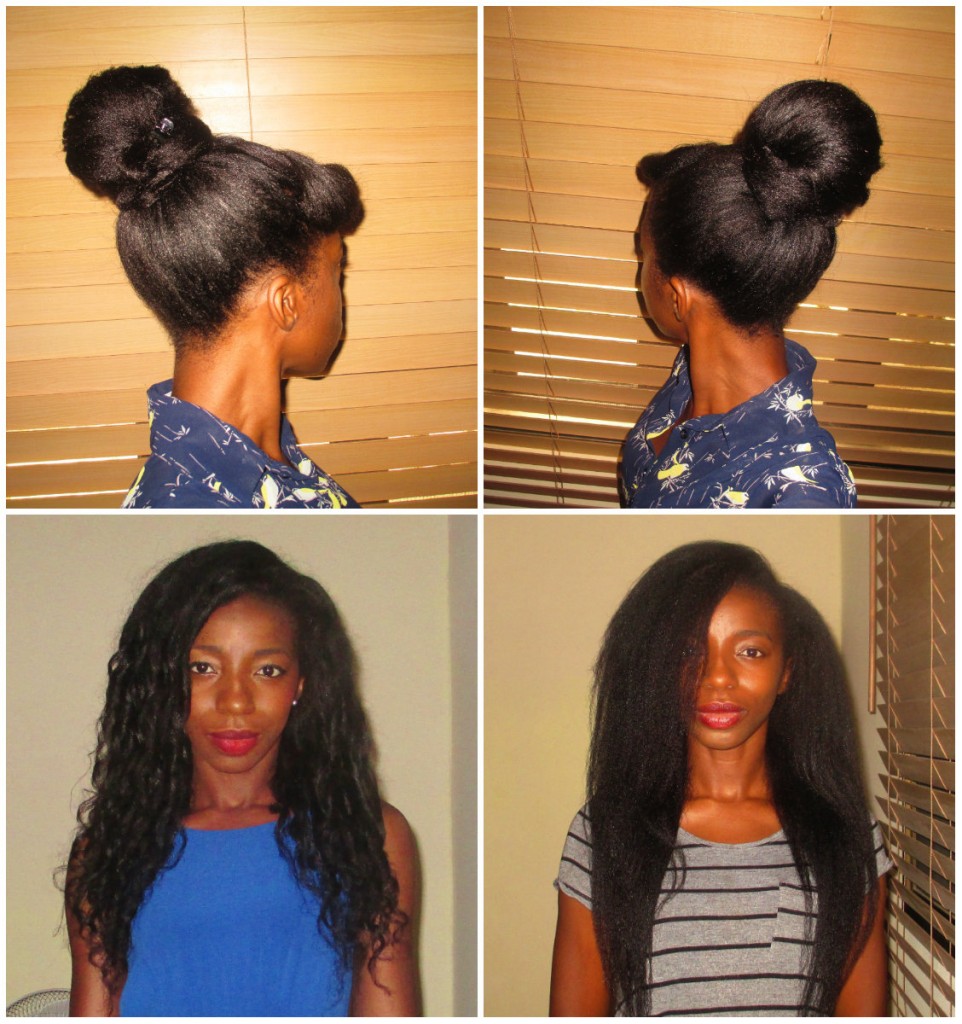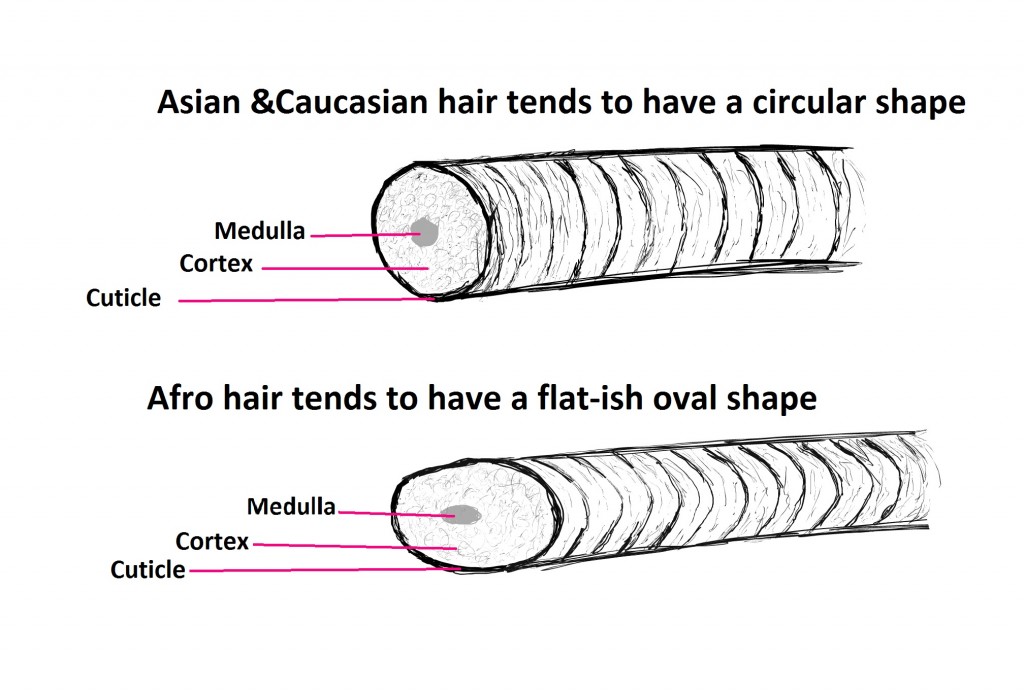
With better understanding of the characteristics of black hair, my hair and I are now in a happy place.
In my first year at university, I had the privilege in living in a very multi-cultural house with five other ladies.
There was Bridget, the English red head, Sandy who was Chinese with pin straight black hair, Sandeep who was Indian and had wavy dark brown hair, Zara who was of mixed heritage (Chinese and English) and had straight dark brown and very shiny hair, Colleen who was Jamaican and myself from Nigeria, we both had relaxed hair. We all got along really well and used to joke that we were the United Colours of Benetton.
Colleen and I became best of friends over the years (she is the one who actually encouraged me to start a hair journey). One of the things we bonded over was complaining about our hair. We would lament about why our hair was so difficult to manage, why did it break so easily, how could our other house mates blow dry and flat iron their hair every day and still have a great head of hair, how come they could chop all their hair off and within a few months it would have grown back, how come they didn’t seem to have any hair issues, what was it about black hair?????
In this blog post I will address some of the differences between Afro, Asian and Caucasian hair and why those differences requires us to care for our hair in a “special” way if we want it to thrive. Please note that the information below provides a general average or overview about the differences between the various hair types and I will be referring majority of the time to afro hair in its natural state.
DIFFERENCES BETWEEN AFRO, ASIAN & CAUCASIAN HAIR
FEWER HAIR FOLLICLES – LESS DENSITY
Hair grows out from our hair follicles (tiny holes) which are located within our scalp. The number of hair follicles a person has determines the overall fullness (density) of that person’s hair. As an example a person with 100 thousand hair follicles should have more hair (more density) than someone with 70 thousand hair follicles. The amount of hair follicles each person is born with is genetically predetermined.
Research has shown that Caucasians and Asians on average have more hair follicles (higher density) than we do. So although our natural (chemically unprocessed) hair may look fuller than straight hair we actually have fewer hair strands.
INDIVIDUAL STRAND THICKNESS
The shape and size of each hair stand is determined by the shape of the follicle it grows out from. Our hair follicles moulds our hair strands as they leave the follicle and are pushed out of our scalp.
The cross section of Asian and Caucasian hair follicles shows that is has a circular shape whilst the cross section of Afro hair follicle shows that it has an oval shape.
The effect of our oval shaped hair follicle is that our hair strands tend to be smaller in diameter than Asian and Caucasian hair.
Hair strands that are fine/ thin tend to have higher tendency to tangle and will break easier as a result of tangling.
SHAPE OF OUR HAIR STRANDS
Due to the oval shape of our hair follicles, the hair produced is slightly flatter in shape than Asian and Caucasian hair. The unique shape of our hair strands means that we have more flat surface area to incur damage when we blow dry, flat iron, handle our hair or comb it aggressively.
The flattened shaped of our hair makes it easier for it to sustain damage.
UNEVEN THICKNESS OF EACH STRAND
Asian or Caucasian hair strands tends to have an even thickness from root to tip. A strand of black hair however tends to have uneven thickness from root to tip. This is because our hair is curly/kinky and the point at which the bend or curl occurs in our hair strand is usually flatter or thinner than the rest of the hair strand. Each curve/bend is an area that weaker than the rest of the hair strand because of the thinness of that spot.
We therefore have several fragile/weak spots along each strand of our hair.
As a summary of the points above, our hair is not as full, the strands are thinner which means it has a higher tendency to tangle and break as a result of tangling, it sustains damage easier because of its flattened shape, we have points of weakness across each hair strand and our hair is drier than theirs making it more susceptible to breakage.
I hope setting out all this not make you think our hair is bad or poorly designed. I decided to write this blog post to emphasise why we simply cannot treat our hair the same way as Asians and Caucasians do. It is easier for them to retain length simply because their hair does not break and sustain damage as easily as ours.
Our hair is different and how we care for it should reflect these differences. This is why we as black women probably have to invest a little more time and effort in caring for our hair. Deep conditioning, protective styling and all the little extra things we do to our hair is a must, especially when it has been relaxed or coloured.
I don’t know about you but I grew up thinking our hair was a lot tougher and could tolerate a lot more abuse that Asian/Caucasian hair. But now I know that the opposite is actually the truth; our hair is a lot more fragile. What are some of the misconceptions you had about black hair before your hair journey?
As always I hope you’ve found this blog post a worthwhile read. The next blog post will be a hair update which I hope you’ll come back soon for.
X
Lade
Learn | Change | Grow
#bringbackourgirls


Thanks for the super informative post Lade! You’re not alone, we all grew up thinking our hair was tougher but are we to be blamed, check out the kinkiness!lol. All in all i think Afro hair is just as beautiful as Caucasian and Asian hair and would thrive just as well or even better with proper care and management!
Author
I am glad you found the post informative Damilola!!!!!
I know, when I was natural in my early teens my hair broke a comb…I thought at that point that black hair was like steel…lol
looking back now I was trying to force a small comb through dry hair, I should have misted it and combed it in sections….I just didn’t know better
But the tides have changed and natural or relaxed we are all better informed
Happy hair journey
xx
Lade
All my friends(and I) used to think that because afro hair looked fuller it was stronger than the other hair types, we also used to think(ermm… this ones stupid)that anytime we flat iron our hair it gets better and grows…I was 7. My mum and I thought that relaxing the hair because it gets straight it grows more .-. When I started my hhj and found out everything I thought was fake…. I was like ooohh… thats why my hair didnt grow.
You also missed another point asian and causacian hair have more sebum in their scalp and tend to have oilier scalp, thats why the GHE doesnt work for them…and they also have to wash their hairs more often than we do
My hhj is going great I reached apl finally because my hair has a v shape only the ends reach my armpit…I do the GHE just to keep my hair moisturized at night, you could try it 🙂 My next goal i bsb, I hope to get there early next year or before…
Cant wait for your hair update, its july you should be preparing for relaxer day xDD
Author
Hello Adanna
Thank you for your comment. Yes so many of us had bad hair care practices.
There are many studies about how much sebum we produce, some say we produce less sebum, some say we produce the same amount and some say we produce less, all the studies I have come across do agree that our hair is drier because the sebum we produce dose not travel as effectively through our hair shaft. So you are right our hair is drier. I also highlighted this point in bold text in the post above however I didn’t discuss it in great detail because I have mentioned in other blog post I have written.
I like to keep my hair regimen simple and prefer to moisturise and seal my hair if it feels dry. I tried the green house very early on in my journey but didn’t like how it made by hair feel. Thanks for the heads up though
Yes its almost time for me to texlax again 🙂
Your hair was definitely growing— just not retaining length. 😊 All hair grows, unless you have a health condition or entering baldness. Very happy that misinformation about curly and kinky hair is being replaced with accurate info and healthy hair care practices. Our hair is soo beautiful (i think more) and so versatile–i love it that more and more of us are Embracing and truly loving our hair and realizing that we Are beautiful in it. ✌
I used to believe that our hair was thicker than that of the caucasians and asians. And then while growing up, I thought my hair could actually grow as fast as that of an indian girlfriend I once had; until I was proven otherwise.
Author
Hey Bisola, yes a lot of us had the same views. A lot of us actually have hair that grows at average rate, breakage is our problem so it seems as though our hair doesn’t grow
well we are Hairducated now!!!
Happy hair journey
x
Lade
A super informative post. Thanks Lade. I had no idea about the flattened shape. Makes sense that it can be more “damageable” if there’s a word like that!
I’m with you on the breaking combs, my hair broke many a comb when i was younger and the hair stylists that used to weave our hair in my boarding school often refused to do mine because it was mega hard/tough and relaxers hardly ever worked. My biggest misconception was that water should not touch my hair. Funny thing is that was the only time i could comb it – if only i knew what proper moisturising and sealing was back then…